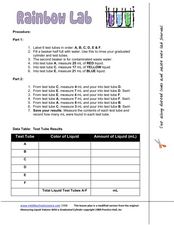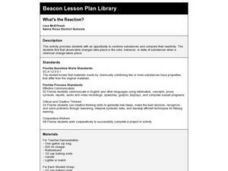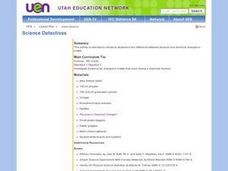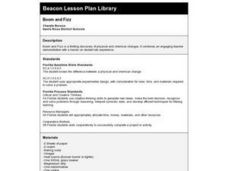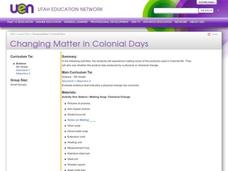Curated OER
Reversible and irreversible changes
Students define the words "reversible" and "irreversible." They complete a worksheet that shows a number of changes. Students must decide which are reversible and which are irreversible.
Curated OER
Physical or Chemical Change
In this matter worksheet, students read statements about changes happening to matter and classify the change as either a physical or a chemical change. This worksheet is a graphic organizer.
Curated OER
Icecream in a Baggie
Students apply their comprehension of colligative properties to real-world situations. They review the concepts of physical and chemical changes. Students are reminded that science is used extensively in food-production. They are...
Curated OER
Winogradsky Column Unit
Students are introduced to two changes, physical and chemicl, in order to prepare them to comprehend what changes take place in a Winogradsky Column. They participate in two activities including completion of a worksheet, balloon...
Curated OER
Boot Reer Root Beer
Fifth graders investigate chemical reactions. In this physical science lesson, 5th graders make dry ice root beer and identify the type of change that occurs to the root beer mixture.
Curated OER
Mad Science Lab: Original Lesson Plan
Students conduct a number of simple experiments, collect and categorize the results as either chemical or physical change. The lesson plan uses connections to folklore, science fiction and comic books to assist each student as they make...
Curated OER
Rainbow Lab
In this mixtures worksheet, students experiment with different amounts of solutes and solvents to make solutions. They observe color changes and look for chemical and physical changes in the test tubes. Students answer 5 questions and...
Curated OER
What's the Reaction?
Students combine baking soda and vinegar and observe the chemical and physical changes that this mixture can produce.
Curated OER
Physical and Chemical Changes
Sixth graders complete several experiments about chemical and physical changes. In this physical and chemical science lesson, 6th graders complete 6 experiments about chemical and physical changes. Students examine the processes of...
American Chemical Society
From Gas to Liquid to Solid
From gas to liquid condensation to solid frost, water undergoes phase changes before students' eyes! Using ice, salt, water, and a metal can, they set up an investigation that can be used in a physical science setting, or as part of a...
American Chemical Society
Evaporation
This is one in several lessons that explore the relationship between temperature and phase changes of water. After some discussion, elementary physical scientists place wet paper toweling on a hot and a room-temperature water bag and...
American Chemical Society
Curious Crystals
Crystals are more than meets the eye! Can learners tell them apart simply by observation? As they examine five samples with a magnifier, they find that appearance alone is not enough. This serves as an introduction to a mini unit on...
American Chemical Society
Exploring Moisture on the Outside of a Cold Cup
As a stand-alone or as part of the intended unit, this is a valid investigation of what causes condensation to occur. By limiting the amount of air around a cold cup of water and comparing it to one out in the open, they find that the...
Curated OER
ChromaCool!
Fifth graders watch a video about physical and chemical changes. In groups, they participate in a variety of activities involving color. They write their observations in a journal. To end the lesson, they use a checklist to classify...
Curated OER
Science Detectives
Fifth graders examine the differences between chemical and physical changes. As a class, they are read a scenerio and determine whether it was deliberate act or not. In groups, they observe the changes of an alka-seltzer tablet and...
Curated OER
Activity #9 Tye Green Blob
Students comprehend that a chemcial change produce substances with a different composition and physical and chemcial properties. They state the differences between physical and chemical changes. Pupils observe changes that occur during...
Curated OER
Physical or Chemical- That Is the Question!
Learners differentiate physical and chemical changes. For this chemistry lesson, students give examples of each type of change. They take the review quiz at the end of the lesson.
Curated OER
Boom and Fizz
Students investigate the differences between a physical and chemical change. They observe various demonstrations involving physical or chemical changes, make predictions, and record what they see, hear, and smell.
Curated OER
Hidden Science in Colonial Living
Fifth graders evaluate evidence that indicates a physical change has occurred. In this colonial living lesson, 5th graders explore the science involved in the making of items used in colonial life, such as, bread, butter, soap, candles,...
Curated OER
Colonial Life
Fifth graders explore American colonial life. In this interdisciplinary history and science lesson, 5th graders participate in several hands-on activities that require them to make colonial products that involve physical or chemical...
Curated OER
States of Matter and Chemical/Physical Changes Stations
Students break into four groups, starting at different stations. Each station should take about 10 minutes depending on prior knowledge of the topic. They then rotate when everyone is finished to the next station and discuss answers of...
Curated OER
Burning vs. Heating
Students investigate burning vs. heating and observe the differences. In this burning vs. heating lesson plan, students observe a wooden splint burning and a piece of glass tubing being heated. They answer questions to compare the two...
Curated OER
Conservation During Chemical Reactions
In this chemical reaction worksheet, students are given the details of an experiment where sodium chloride and silver nitrate are mixed in a chemical reaction. Students answer nine questions about the chemical reaction, they determine...
Curated OER
Chemistry: Chemical Reactions
Students investigate chemical reactions. In this chemistry lesson, students burn magnesium and record the mass. Students list five chemical reactions they see everyday.








